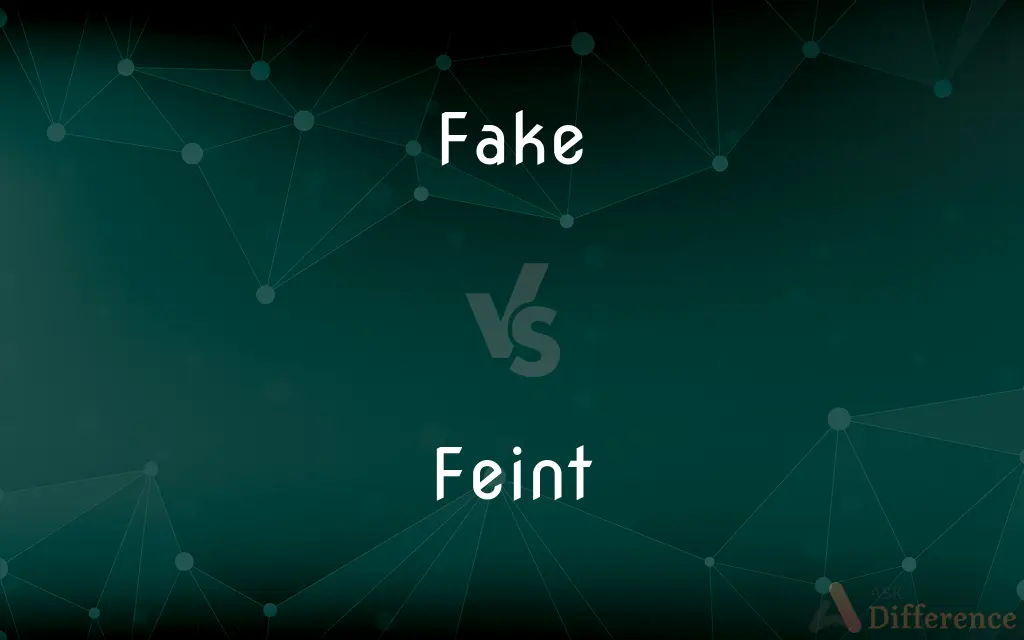Fake vs. Feint — What's the Difference?
Edited by Tayyaba Rehman — By Maham Liaqat — Updated on May 2, 2024
"Fake" implies deception or simulation, often used to mislead, while "feint" refers to a deceptive or pretended movement, especially in sports or military tactics.

Difference Between Fake and Feint
Table of Contents
ADVERTISEMENT
Key Differences
A fake involves pretending something is real or true when it is not, often to deceive. On the other hand, a feint is a specific tactical maneuver intended to distract or mislead an opponent about one’s intended actions.
Faking can occur in various contexts, from personal relationships to media, where individuals or entities present false information as truth. Whereas, feinting is commonly associated with structured activities like martial arts, fencing, or military engagements, where strategic deception is a key element.
In emotional or psychological terms, someone might fake happiness to conceal their true feelings, impacting interpersonal trust when discovered. Conversely, a feint in sports, such as a basketball player pretending to move one direction and then going another, is generally accepted as part of strategic play.
The consequences of faking can be more severe and far-reaching, potentially leading to legal or social repercussions if the falsehoods are significant. In contrast, a successful feint usually leads to immediate tactical advantages within the rules of the game or battle context.
While faking is often considered unethical or morally questionable, feinting is typically viewed within the norms of competitive behavior, recognizing it as a skillful use of misdirection rather than outright deceit.
ADVERTISEMENT
Comparison Chart
Definition
An act of deception to create a false appearance.
A deceptive maneuver intended to mislead an opponent.
Contexts
Broad (social, emotional, informational).
Specific (sports, military tactics).
Perception
Generally negative, associated with dishonesty.
More neutral, seen as strategic and skillful.
Consequences
Can lead to trust issues, legal problems.
Usually limited to the context of the game or battle.
Ethical Consideration
Often viewed as unethical depending on intent and impact.
Accepted as part of strategic conduct in specific fields.
Compare with Definitions
Fake
Imitation designed to deceive.
The document was a fake, designed to trick investors.
Feint
A deceptive or pretended blow, thrust, or other movement in sports.
His quick feint fooled the goalkeeper, opening up the net for a goal.
Fake
Anything made to appear otherwise than it actually is; counterfeit.
He wore a fake smile to avoid questions about his health.
Feint
A misleading movement or pretended attack.
The boxer used a feint to distract his opponent before the real punch.
Fake
To pretend or simulate falsely; feign.
She faked illness to avoid going to school.
Feint
A movement made in order to deceive an adversary.
Her feint left caught the defender off-guard, allowing her to score.
Fake
Not genuine; simulated.
They used fake fur on the costumes for ethical reasons.
Feint
A military maneuver designed to mislead enemies about the actual point of attack.
The army's feint drew the enemy to the south, while the main force attacked from the north.
Fake
To reproduce something for a deceitful or fraudulent purpose.
He was caught trying to fake his manager's signature.
Feint
An action intended to divert attention from one's true purpose.
The spy's feint involved acting like a tourist to avoid suspicion.
Fake
Not genuine; imitation or counterfeit
She got on the plane with a fake passport
A fake Cockney accent
Feint
Feint is a French term that entered English via the discipline of swordsmanship and fencing. Feints are maneuvers designed to distract or mislead, done by giving the impression that a certain maneuver will take place, while in fact another, or even none, will.
Fake
A thing that is not genuine; a forgery or sham
Fakes of Old Masters
Feint
A military attack or maneuver that is meant to divert attention away from a planned point of attack.
Fake
Variant spelling of flake
Feint
A body movement that is intended to divert another's attention, often by being deliberately left uncompleted
"The mongoose begins with a feint, which provokes the snake to strike" (Norbert Wiener).
Fake
Forge or counterfeit (something)
She faked her spouse's signature
Feint
A deceptive action calculated to divert attention from one's real purpose.
Fake
Variant spelling of flake
Feint
To make a feint
"He feinted with his left hand, trying to distract the turtle and then grab its tail" (Howard Frank Mosher).
Fake
Having a false or misleading appearance; fraudulent.
Feint
To deceive with a feint
He feinted his opponent with a left hook.
Fake
One that is not authentic or genuine; a sham.
Feint
To do or perform as a feint
Feinted a punch.
Fake
(Sports) A brief feint or aborted change of direction intended to mislead one's opponent or the opposing team.
Feint
A movement made to confuse an opponent; a dummy.
Fake
One loop or winding of a coiled rope or cable.
Feint
A blow, thrust, or other offensive movement resembling an attack on some part of the body, intended to distract from a real attack on another part.
Fake
To contrive and present as genuine; counterfeit
Fake a signature.
Feint
(figuratively) Something feigned; a false or pretend appearance; a pretence or stratagem.
Fake
To simulate; feign
Faked his death so his wife would collect insurance money.
Feint
To direct (a blow, thrust, or other offensive movement resembling an attack) on some part of the body, intended to distract from a real attack on another part.
Fake
(Music) To improvise (a passage).
Feint
(rare) To direct a feint or mock attack against (someone).
Fake
(Sports) To deceive (an opponent) with a fake. Often used with out.
Feint
To make a feint or mock attack.
Fake
To engage in feigning, simulation, or other deceptive activity.
Feint
Of an attack or offensive movement: directed toward a different part from the intended strike.
Fake
(Sports) To perform a fake.
Feint
(obsolete) Feigned, counterfeit, fake.
Fake
To coil (a rope or cable).
Feint
Of lines printed on paper as a handwriting guide: not bold; faint, light; also, of such paper: ruled with faint lines of this sort.
Fake
Not real; false, fraudulent
Which fur coat looks fake?
Feint
Feigned; counterfeit.
Dressed up into any feint appearance of it.
Fake
(of people) Insincere
Feint
That which is feigned; an assumed or false appearance; a pretense; a stratagem; a fetch.
Courtley's letter is but a feint to get off.
Fake
Something which is not genuine, or is presented fraudulently.
I suspect this passport is a fake.
Feint
A mock blow or attack on one part when another part is intended to be struck; - said of certain movements in fencing, boxing, war, etc.
Fake
(sports) A move meant to deceive an opposing player, used for gaining advantage for example when dribbling an opponent.
Feint
To make a feint, or mock attack.
Fake
(archaic) A trick; a swindle
Feint
Any distracting or deceptive maneuver (as a mock attack)
Fake
(nautical) One of the circles or windings of a cable or hawser, as it lies in a coil; a single turn or coil.
Feint
Deceive by a mock action;
The midfielder feinted to shoot
Fake
(transitive) To make a counterfeit, to counterfeit, to forge, to falsify.
Fake
(transitive) To make a false display of, to affect, to feign, to simulate.
To fake a marriage
To fake happiness
To fake a smile
Fake
(archaic) To cheat; to swindle; to steal; to rob.
Fake
(archaic) To modify fraudulently, so as to make an object appear better or other than it really is
Fake
To improvise, in jazz.
Fake
(nautical) To coil (a rope, line, or hawser), by winding alternately in opposite directions, in layers usually of zigzag or figure of eight form, to prevent twisting when running out.
Fake
One of the circles or windings of a cable or hawser, as it lies in a coil; a single turn or coil.
Fake
A trick; a swindle.
Fake
To coil (a rope, line, or hawser), by winding alternately in opposite directions, in layers usually of zigzag or figure of eight form,, to prevent twisting when running out.
Fake
To cheat; to swindle; to steal; to rob.
Fake
To make; to construct; to do.
Fake
To manipulate fraudulently, so as to make an object appear better or other than it really is; as, to fake a bulldog, by burning his upper lip and thus artificially shortening it.
Fake
Something that is a counterfeit; not what it seems to be
Fake
A person who makes deceitful pretenses
Fake
(football) a deceptive move made by a football player
Fake
Make a copy of with the intent to deceive;
He faked the signature
They counterfeited dollar bills
She forged a Green Card
Fake
Fake or falsify;
Fudge the figures
Cook the books
Falsify the data
Fake
Talk through one's hat;
The politician was not well prepared for the debate and faked it
Fake
Fraudulent; having a misleading appearance
Fake
Not genuine or real; being an imitation of the genuine article;
It isn't fake anything; it's real synthetic fur
Faux pearls
False teeth
Decorated with imitation palm leaves
A purse of simulated alligator hide
Common Curiosities
What skills are required to effectively perform a feint?
Effective feinting requires quick thinking, agility, and the ability to predict and manipulate opponents' reactions.
How is a feint useful in sports?
In sports, a feint is used to mislead opponents about one’s actual movements or intentions, creating opportunities for scoring or defense.
Why might someone choose to fake something?
Individuals might choose to fake something for personal gain, to protect themselves or others from harm, or to manipulate outcomes.
How do people generally react to discovering a fake?
Discovering a fake often leads to feelings of betrayal and mistrust, impacting relationships and credibility.
What are the consequences of relying on feints too often in a strategy?
Over-reliance on feints can make a person or team predictable, allowing opponents to adapt and counter effectively.
Is it possible to detect when someone is faking?
Detecting faking can be challenging, requiring attention to inconsistencies in behavior, speech, or evidence.
Can faking ever be considered harmless?
Sometimes, faking, like pretending to be happy in social situations, can be considered harmless and a part of social etiquette.
What is the main purpose of a fake?
The main purpose of faking is to deceive, often to gain some advantage or hide the truth.
What measures can be taken to reduce faking in important matters?
Implementing strict verification processes and promoting a culture of honesty can help reduce the incidence of faking in critical areas like business and personal relationships.
Are there ethical considerations in using feints in competitive environments?
Yes, while generally accepted, the ethics of using feints depends on the spirit of the competition and fairness.
Share Your Discovery

Previous Comparison
Crow vs. Vulture
Next Comparison
Bibliography vs. IndexAuthor Spotlight
Written by
Maham LiaqatEdited by
Tayyaba RehmanTayyaba Rehman is a distinguished writer, currently serving as a primary contributor to askdifference.com. As a researcher in semantics and etymology, Tayyaba's passion for the complexity of languages and their distinctions has found a perfect home on the platform. Tayyaba delves into the intricacies of language, distinguishing between commonly confused words and phrases, thereby providing clarity for readers worldwide.
















































